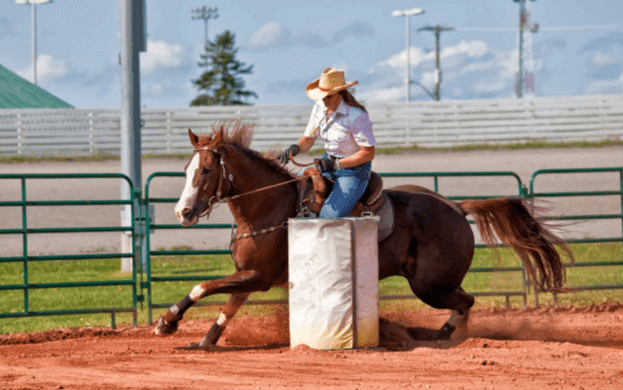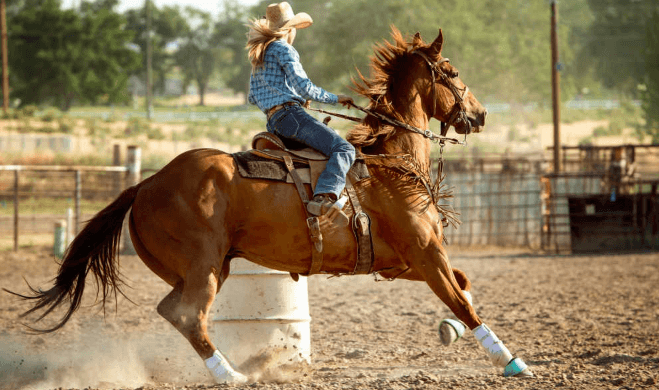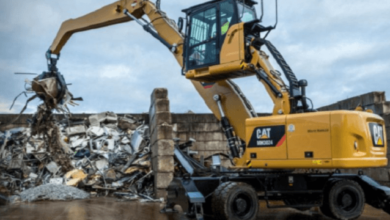What are the techniques for successful barrel racing?

Introduction
Barrel racing is a thrilling and demanding equestrian sport that tests both the horse’s agility and the rider’s precision. Originating from rodeos, this timed event involves navigating a cloverleaf pattern around barrels in the fastest time possible. Success in barrel racing requires a blend of speed, control, and skill. This article delves into the techniques that can help you excel in barrel racing, covering everything from horse training to riding strategies.
Understanding Barrel Racing
The Basics of Barrel Racing
Barrel racing involves a horse and rider navigating a cloverleaf pattern around three barrels set in a triangular formation. The objective is to complete the pattern in the shortest time without knocking over any barrels.
History of Barrel Racing
Originating in the early 20th century, barrel racing started as a rodeo event primarily for women. Over the years, it has evolved into a competitive sport with specific rules and governing bodies.
Importance of Speed and Precision
While speed is crucial, precision in maneuvering the barrels is equally important. A slight misstep can lead to penalties or disqualification, emphasizing the need for both quickness and accuracy.
Choosing the Right Horse
Breeds Suited for Barrel Racing
Certain horse breeds are naturally inclined toward barrel racing due to their speed, agility, and temperament. Popular breeds include the American Quarter Horse, Paint Horse, and Appaloosa.
Evaluating Horse Temperament
A successful barrel racing horse should have a calm yet energetic disposition. The horse must be responsive to commands and exhibit a willingness to learn and perform under pressure.
Assessing Physical Attributes
Key physical traits for barrel racing horses include strong legs, a muscular build, and a well-balanced body. These attributes contribute to the horse’s ability to make quick, sharp turns and accelerate rapidly.
Horse Training Techniques
Starting with Groundwork
Groundwork is the foundation of any training regimen. It establishes trust and communication between the horse and rider, essential for successful barrel racing.
Building Endurance and Strength
Conditioning the horse through regular exercise routines that include sprints, long-distance riding, and hill work helps build the necessary endurance and strength.
Drills for Agility and Speed
Incorporating agility drills such as figure-eights, rollbacks, and lead changes improves the horse’s maneuverability and quickness, crucial for navigating the barrel pattern.
Desensitization Training
Exposing the horse to various stimuli, such as loud noises and sudden movements, helps desensitize them to distractions they might encounter during a race.
Rider Skills and Techniques
Developing a Balanced Seat
A balanced seat is fundamental for maintaining control and stability. Riders should practice keeping their weight centered and evenly distributed to stay in harmony with the horse’s movements.
Mastering Rein Control
Effective rein control enables precise communication with the horse. Riders should practice using gentle yet firm rein cues to guide the horse smoothly around the barrels.
Improving Leg Cues
Leg cues play a significant role in steering and speeding up the horse. Practicing clear and consistent leg signals can enhance the horse’s responsiveness.
Maintaining Focus and Composure
Staying focused and composed, especially under the pressure of competition, is vital. Riders should develop mental strategies to stay calm and concentrated during the race.
Perfecting the Barrel Pattern
Understanding the Cloverleaf Pattern
The standard cloverleaf pattern involves making a right turn around the first barrel, followed by two left turns around the second and third barrels, or vice versa. Understanding this pattern is crucial for planning the race strategy.
Practicing Approach and Turns
Riders should practice the approach to each barrel and the turning techniques. Smooth and tight turns can save precious seconds and reduce the risk of knocking over barrels.
Timing and Rhythm
Establishing a consistent rhythm and timing for the horse’s strides ensures a fluid and efficient run. Riders should practice maintaining a steady pace throughout the pattern.
Analyzing and Adjusting Techniques
Regularly analyzing performance through video reviews or coaching can help identify areas for improvement. Adjusting techniques based on feedback is essential for continuous progress.
Tack and Equipment
Choosing the Right Saddle
A barrel racing saddle should be lightweight, with a high cantle and deep seat for better stability and control. The saddle should also fit both the horse and rider comfortably.
Selecting Suitable Bridles and Bits
The choice of bridle and bit can influence the horse’s responsiveness and comfort. Riders should select equipment that offers precise control without causing discomfort to the horse.
Using Protective Gear
Protective gear such as leg wraps, bell boots, and skid boots can prevent injuries during high-speed turns and sudden stops. Ensuring the horse’s safety is paramount.
Maintenance and Care of Equipment
Regular maintenance of tack and equipment is essential to ensure safety and performance. Riders should inspect their gear for wear and tear and perform necessary repairs or replacements.
Conditioning and Health
Regular Vet Check-ups
Routine veterinary check-ups ensure the horse remains in optimal health. Regular health assessments can prevent potential issues that might affect performance.
Proper Nutrition and Diet
A balanced diet rich in proteins, vitamins, and minerals supports the horse’s overall health and performance. Consulting with a nutritionist can help create a tailored feeding plan.
Hydration and Electrolytes
Maintaining proper hydration and electrolyte balance is crucial, especially during intense training and competition. Adequate water intake and electrolyte supplements can prevent dehydration and fatigue.
Rest and Recovery
Providing ample rest and recovery time allows the horse to recuperate from strenuous activities. Adequate rest prevents injuries and promotes long-term performance.
Competitions and Events
Preparing for Competitions
Preparation involves both mental and physical readiness. Riders should plan a training schedule leading up to the competition and ensure all logistics are in place.
Understanding Competition Rules
Familiarizing oneself with the rules and regulations of the competition helps avoid penalties and ensures fair play. Riders should stay updated on any rule changes.
Strategies for Race Day
On race day, having a clear strategy can make a significant difference. Riders should plan their warm-up routines, mental focus techniques, and race execution strategies.
Analyzing Post-Race Performance
Post-race analysis is crucial for identifying strengths and areas for improvement. Reviewing race footage and seeking feedback from coaches can provide valuable insights.
Safety Measures
Ensuring Rider Safety
Rider safety is paramount. Wearing appropriate safety gear, such as helmets and protective vests, can prevent serious injuries in case of falls or accidents.
Horse Safety and Welfare
Ensuring the horse’s safety involves regular health checks, proper training techniques, and using suitable equipment. A healthy and happy horse performs better.
Emergency Preparedness
Being prepared for emergencies involves having a first aid kit and knowing basic first aid procedures. Riders should also have emergency contact numbers readily available.
Building a Strong Bond
Trust and Communication
Building a strong bond with the horse is essential for successful barrel racing. Trust and effective communication between the rider and horse lead to better performance.
Spending Quality Time
Spending quality time outside of training sessions helps strengthen the bond. Activities like grooming, leisure riding, and just being around the horse contribute to a deeper connection.
Positive Reinforcement
Using positive reinforcement techniques, such as treats and praise, encourages desired behaviors and enhances the training process.
Common Challenges and Solutions
Overcoming Fear and Anxiety
Both horses and riders may experience fear and anxiety. Gradual exposure to competitive environments and building confidence through practice can help overcome these challenges.
Dealing with Injuries
Injuries are an inevitable part of any sport. Having a good rehabilitation plan and consulting with veterinarians and trainers ensures proper recovery and return to the sport.
Managing Competition Pressure
Competition pressure can be intense. Developing mental resilience through visualization techniques, breathing exercises, and a positive mindset can help manage stress.
Advanced Techniques for Experienced Riders
Mastering Advanced Turns
Experienced riders can refine their turning techniques by practicing advanced maneuvers like rollback turns and counter-cantering.
Fine-Tuning Speed Control
Fine-tuning speed control involves mastering the balance between acceleration and deceleration. Riders should practice controlling speed without sacrificing precision.
Customizing Training Regimens

Customizing training regimens based on the horse’s strengths and weaknesses can lead to significant improvements. Riders should work with trainers to develop tailored training plans.
Incorporating Technology
Incorporating technology, such as GPS trackers and performance monitoring apps, provides data-driven insights for optimizing performance and training.
FAQs
What are the best horse breeds for barrel racing? Popular breeds for barrel racing include the American Quarter Horse, Paint Horse, and Appaloosa due to their speed, agility, and temperament.
How can I improve my horse’s turning speed? Improving turning speed involves practicing agility drills, refining turning techniques, and building the horse’s strength and flexibility through targeted exercises.
What equipment is essential for barrel racing? Essential equipment includes a lightweight barrel racing saddle, suitable bridle and bit, protective leg gear, and a well-maintained horse trailer for transportation.
How often should I train my horse for barrel racing? Regular training is crucial, but it should be balanced with adequate rest. A typical regimen might include training sessions 3-5 times a week, depending on the horse’s condition and competition schedule.
What should I do if my horse gets injured? If your horse gets injured, consult a veterinarian immediately. Follow the recommended rehabilitation plan and ensure the horse gets ample rest and care to recover fully.
How can I reduce competition anxiety? Reducing competition anxiety involves mental preparation techniques such as visualization, deep breathing exercises, and maintaining a positive mindset. Building confidence through regular practice also helps.
Conclusion
Barrel racing is an exhilarating sport that demands a perfect blend of speed, skill, and synergy between horse and rider. By understanding and applying the techniques discussed in this article, you can enhance your performance and achieve success in barrel racing. Remember, consistent practice, a strong bond with your horse, and a positive mindset are key to mastering this challenging yet rewarding sport.





